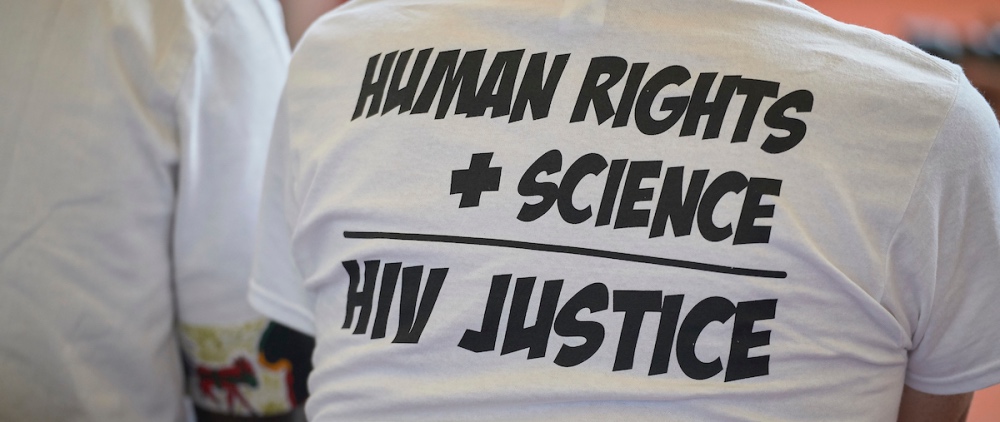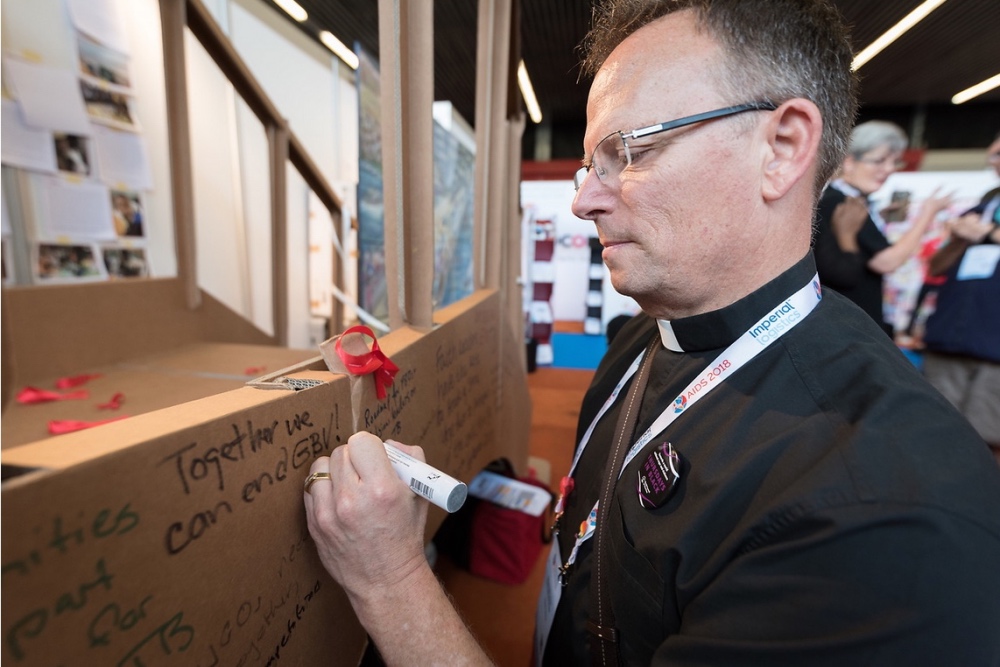
PAUL JEFFREY, in an article first published on the World Council of Churches website, reports from this year’s International AIDS Conference in Amsterdam…
Every two years, the International AIDS Conference provides scientists with a venue to announce new discoveries in how HIV is diagnosed and treated. This year, the 23rd to 27th July conference, held in Amsterdam, was no exception.
Yet discoveries in scientific labs aren’t going to save the world, and faith-based organisations present for the conference heard repeatedly that their unique contribution to the struggle with AIDS is vital.
“We broke the conspiracy of silence, but now we face the conspiracy of complacency,” said Michel Sidibé, the executive director of the Joint United Nations Program on HIV/AIDS (UNAIDS), in a 24th July conversation with faith leaders at the conference. “Science is important. But social change is also needed, and social change happens with faith-based organisations.”

PICTURE: Paul Jeffrey/WCC
Sidibé’s organisation recently warned that while progress had been made in testing, treatment and prevention of HIV in many settings, new infections are on the rise in some regions and among several key populations, and drug-resistant forms of the wily virus are now appearing around the world.
And soon a booming population of children and adolescents, particularly in sub-Saharan Africa, will be particularly susceptible to infection following years of overly-optimistic messaging about the end of AIDS as a public health threat.
“It is impossible for us to reach those who are difficult to reach and really remove the barriers of stigma and discrimination. We need people who all their lives have been building bridges between people. That is who you are.”
– Michel Sidibé, the executive director of UNAIDS, speaking to religious leaders.
UNAIDS has also warned that global funding for the AIDS response, while relatively stable, is not sufficient to reach previously unreachable sectors.
“It is impossible for us to reach those who are difficult to reach and really remove the barriers of stigma and discrimination,” Sidibé told the religious leaders. “We need people who all their lives have been building bridges between people. That is who you are.”
With leadership from the World Council of Churches Ecumenical Advocacy Alliance, religious leaders and activists attending the conference emphasised the construction of bridges between faith communities and others involved in responding to the global pandemic. Participants in a two-day interfaith conference in anticipation of the International AIDS Conference constructed a symbolic cardboard bridge. They then moved it to the Global Village of the main conference, where it linked together the “Interfaith Networking Zone” and a discussion area shared with the World Health Organization, UNAIDS and Unitaid.
The interfaith conference focused on three critical issues where faith-based organisations need to step up their game.
One of those is how to better reach children and adolescents who have often been left behind by HIV testing and treatment programs. Participants heard updates on a process convoked by Pope Francis to push manufacturers of drugs and diagnostic devices to develop products better suited to children.
Francesca Merico, coordinator of the WCC-EAA HIV Campaign, is part of a small working group that monitors progress made on what has become known as the Rome Action Plan.
“There are a variety of different stakeholders involved, all committed to accelerating the research, development, introduction and regulatory approval of optimal formulations. It’s not just the responsibility of pharmaceutical companies to ensure that children have access to treatment. It’s also the responsibility of faith-based organisations to roll out the optimal formulations in each country, which sometimes doesn’t happen. We need to invest in what children really need, not just a drug,” Merico said.
Another issue at the pre-conference was tuberculosis (TB) and its insidious relation with HIV. TB is the most common cause of death for people who develop AIDS, and HIV infection has contributed to a significant increase in the worldwide incidence of TB.
In addition to experts on the disease from the World Health Organization and other agencies, participants listened to Maureen Murenga from Kenya describe how TB is often more stigmatized than HIV. Both Murenga and her son are living with HIV, but it was only when it became known that her son was on treatment for TB that other parents removed their children from his school, even though the boy was no longer contagious.
“We cannot save lives if we only focus on HIV,” Murenga said.

After morning prayers in the Interfaith Networking Zone, Mike Schuenemeyer writes a message on a symbolic bridge, expressing hopes and challenges for a coordinated response to HIV, particularly in view of the work against sexual and gender-based violence. The morning prayer was held on the theme of “Faith against Gender based violence – Thursdays in Black”. PICTURE: Albin Hillert/WCC
On a third front, participants also discussed how migrants are affected by HIV. Father Bob Vitillo, a special advisor on HIV and AIDS to Caritas Internationalis, said the world often sees migrants and people living with HIV in the same light.
“Both suffer from marginalisation, from the fear that people have of ‘the other,’” he said. “But the Gospel mandates, at least for Christians, that we be out on the margins with them, recognising the dignity in every person.”
“Both suffer from marginalisation, from the fear that people have of ‘the other’. But the Gospel mandates, at least for Christians, that we be out on the margins with them, recognising the dignity in every person.”
– Father Bob Vitillo, a special advisor on HIV and AIDS to Caritas Internationalis, speaking about similarities in the way migrants and people living with HIV are seen.
Now secretary general of the International Catholic Migration Commission, Vitillo said he is working on ways for the personal data of migrants–who often lose or have their documents taken from them–to be made available to them on the cloud. This could include both health records and identity documents, he said, and would help ensure the continuity of treatment when necessary.
In both conferences, religious leaders recommitted themselves to continuing the promotion of human rights, increasing access to treatment for everyone, and combating stigma and discrimination, three themes that have occupied the interfaith agenda for years.
New challenges were also discussed. Participants celebrated the achievement of what was dubbed “U equals U” at the conference – recently released research that shows that HIV is “untransmittable” by HIV-positive individuals whose viral load has been undetectable for several months. That allows serodiscordant couples, for example, to have unprotected sex, thus sidestepping a moral dispute which for years has perplexed some Catholics over the use of condoms. But it can also contribute (along with pre-exposure prophylaxis that is now widely available) to a decline in safer sex practices, something evidenced in several areas by skyrocketing rates of sexually-transmitted diseases like chlamydia, syphilis and gonorrhea–including extensively drug-resistant forms.
Throughout both conferences, faith leaders shared good practices from the field.
For example, Father Richard Bauer, a Maryknoll priest from the United States, shared his experience in a large HIV program in Nairobi, where last year his organisation conducted 60,000 HIV tests.
“Yet we’ve been only testing the ‘worried well,’” he said. “Despite initial concerns, I’ve been converted to using self-testing and assisted self-testing, using community health workers who come from the local area and are trusted by people. It’s a great opportunity to expand our reach, including among men, and when we get data that allow us to identify where new infections are happening, we can send our community health workers into the area and quickly get to those we really need to reach.”
According to Carol Finlay, the twinning and local development secretary for the World Mission Council of the Church of Scotland, despite current setbacks in the struggle with HIV and AIDS, changes in the demographics of the biennial conference give her hope, especially the participation of those whose voices were not heard in the early stages of the pandemic.
Finlay attended the 2000 conference in Durban, and she says the Amsterdam gathering shows how far the AIDS response has come.
“In 2000, we didn’t talk about people living with HIV, simply because people weren’t living with it. People with the virus were on the edges of the conference. But now they’re right in the middle,” she said.
This article was first published on the World Council of Churches website.





